#roman jewellery
Explore tagged Tumblr posts
Text


Roman Jet Bracelets and Bangles, The Yorkshire Museum, York
#romans#roman empire#rome#roman jewellery#jewellery#design#relic#artefacts#roman border#roman army#roman society#roman costume#ancient living#ancient cultures#archaeology
333 notes
·
View notes
Text

A Rare Enameled Roman Brooch Found in Scotland
Researchers believe the brooch came north with Roman soldiers, possibly as a ritual offering or battle trophy.
Excavations undertaken in 2020 at William Grant & Sons Girvan Distillery at the Curragh in South Ayrshire revealed an Iron Age settlement where archaeologists discovered a rare enamelled bronze brooch, believed to have been placed in the foundations of a fortified roundhouse as a sacrifice to grant protection to the household.
The enamelled bronze brooch, thought to date from the late second century CE, may have been used in a foundation offerings ritual at the Iron Age fort, possibly as a votive sacrifice during the construction of the timber palisade around the roundhouse. According to The National, the brooch was recovered from the bottom of the foundation trench that held the timber palisade in place.
"It's difficult to say exactly why the brooch was deposited within the palisade trench, but we know that ritualised foundation offerings are observed across many cultures, typically enacted to grant protection to a household, and this is certainly a possibility here," said Jordan Barbour, who co-authored the report on the findings, according to BBC News.
he team of archaeologists discovered the remains of a timber roundhouse surrounded by a wooden palisade with a gated entranceway, likely the dwelling of a wealthy farming household. According to The National, the Iron Age settlement was situated at the top of a rocky plateau, with a steep slope to the immediate north, and the dwelling may have been sited here and enclosed with a timber palisade due to defensive concerns.
"These brooches were particularly popular among members of the Roman military forces, so it's likely that it came north of Hadrian's Wall on the cloak of a Roman soldier tasked with garrisoning the Empire's northernmost frontier," added Barbour.
The brooch is the only Roman artefact recovered from the site. "If the inhabitants had established regular trade with Roman Britain, we might expect to find a greater variety of Roman objects, but this is a solidly native context," stated Barbour.
He suggested that the brooch may have been obtained through ad hoc exchange with Roman troops operating north of Hadrian's Wall, or perhaps even taken in battle as a trophy. "There was no evidence that the brooch had been worn by a local Briton," he said, according to The National.
Conflict between the locals and Roman soldiers is likely to have been a recurring element of Rome's intermittent occupation of south-west Scotland.
Although there were no contemporary Roman forts nearby after the abandonment of the Antonine Wall earlier in the second century CE, an earlier first century CE Roman marching camp some two kilometres to the south-west attests to previous military presence in the area.
The brooch would have arrived in Scotland at about the time the Roman Empire was losing its grip on the south of the country. The Romans left Scotland around 210 CE but remained in Britain for a further 200 years.
Traces of even more ancient inhabitation were evidenced by the recovery of pottery dating to the early Neolithic period. During the early Neolithic period, a large timber monument was constructed at the site between 3700 and 3500 BCE.
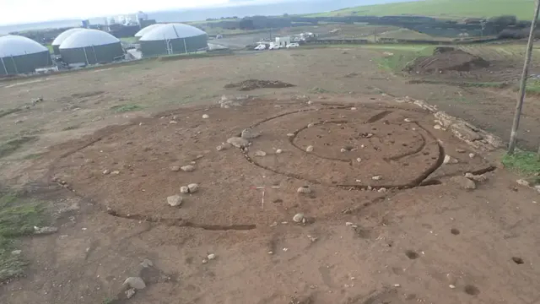
#A Rare Enameled Roman Brooch Found in Scotland#William Grant & Sons Girvan Distillery#roman enameled bronze brooch#ancient artifacts#archeology#history#history news#ancient history#ancient culture#ancient civilizations#roman history#roman empire#roman jewellery#roman art#ancient jewelry#ancient art
51 notes
·
View notes
Text

Dogs in art: Roman gold ring with an agate cameo depicting a sleeping dog with a Greek inscription.
1st–2nd century AD.
Gold and agate.
Private Collection.
#found#art#ancient art#roman#dogs#sleeping dogs#gold ring#Roman jewellery#dogs in art#dogs of tumblr#dog
20 notes
·
View notes
Text
Roman "Asclepius & Hygeia" Carnelian Intaglio Signet Ring

A fascinating antique signet ring with an ancient Roman intaglio. The carnelian agate intaglio depicts two Greek gods- Asclepius, the god of medicine and Hygeia, his daughter and goddess of health. Asclepius carries a snake-entwined staff, while facing his daughter. The ring mount is crafted in solid 18 karat yellow gold.


Asclepius was the son of Apollo and mortal princess Coronis. His name- literally meaning "to cut open" as he was born by caesarean section. He was married to Epione, the goddess of pain relief and healing. Her name comes from the Greek word "epios", which means "soothing". They together had a number of children, including Hygiea. Asclepius was given to the Centaur Chiron, the wisest of all centaurs, who raised him and taught him medicine and the healing arts. Legend has it, at some point along the way, Asclepius healed a snake, which in return taught him secret knowledge... Snakes were considered divine beings that were wise and could heal and this is how his symbol came along.
Hygeia's (hygiene) classical symbol was a bowl containing a medicinal potion with the serpent of wisdom consuming it. This is the same serpent of wisdom, which appears on the staff of Aesculapius. She played an important part in her father's cult, while her father was more directly associated with healing, she was associated with the prevention of sickness and the continuation of good health.

#antique jewelry#butter lane antiques#fine jewelry#antiques#antiquejewelry#butterlaneantiques#mythology jewelry#greek mythology jewelry#greek mythology#greek god#roman jewellery#roman jewelry#roman#fresco#hygeia
10 notes
·
View notes
Photo
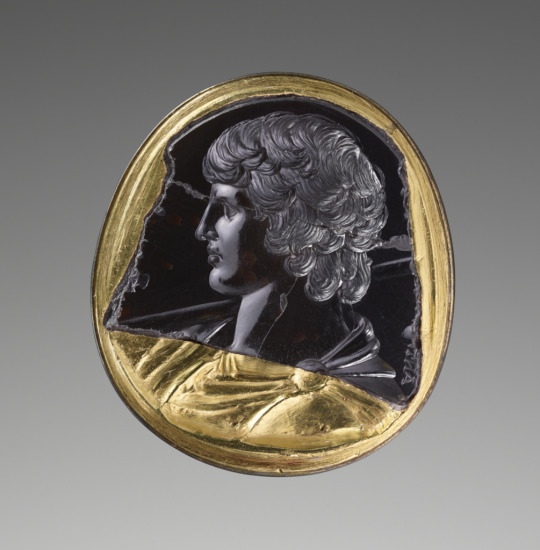
Intaglio with Bust of Antinous, A.D. 131–138
This gem depicts Antinous, the young companion and lover of Emperor Hadrian (AD 117-138), who drowned in the River Nile during their visit to Egypt in AD 130. The grief-stricken emperor instituted a cult in honor of the youth, who was revered as a semi-divine hero.
Artist/Maker: Unknown Culture: Roman Place: Italy; or Greece (Place Created) Date: A.D. 131–138 Medium: Intaglio: Black chalcedony; modern mount: gold Object Number: 2019.13.17 Dimensions: 3.5 × 2.9 cm (1 3/8 × 1 1/8 in.) Inscription(s): Inscribed, in Greek: ΑΝΤΟ
Alternate Title: Antinous (Display Title) Department: Antiquities Classification: Jewelry Object Type: Gem
The J. Paul Getty Museum, Villa Collection, Malibu, California
Antinous is shown here in profil facing to the left; a fibula pins his chlamys in place at his left shoulder. Over his right shoulder, he carries a hunting spear. Behind his left shoulder is a fragmentary vertical inscription written in retrograde Greek letters, beginning ΑΝΤΟ…, perhaps the name of the gem engraver. The intaglio is fragmentary
#ancient art#antinous#hadrian#emperor hadrian#roman jewellery#roman art#ancient jewellery#bust#jewellery#mu#mu ancient#20 notes#20 art
21 notes
·
View notes
Photo
A couple of further images of this gorgeous wreath.


Image source
Original caption: Golden Decorated Crown, Funerary or Marriage Material, 370–360 BC. From a Grave in Armento (Campania)

Golden crown, detail
* 370-360 BCE
* Discovered from a grave in Armento, Basilicata.
Attribution: Staatliche Antikensammlungen, CC BY-SA 3.0 <http://creativecommons.org/licenses/by-sa/3.0/>, via Wikimedia Commons; photo by Matthias Kabel
288 notes
·
View notes
Text

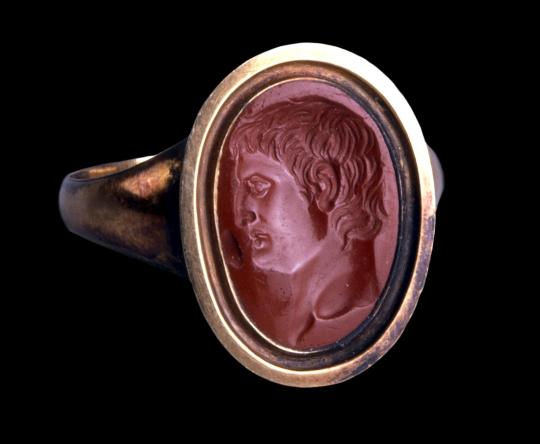
Red Jasper Sealstone Intaglio of Heroic Antonius.
Roman c 40-30BC
L: 1.40 cm/W: 1 cm
An exceptionally clear profile portrait, with long, tousled hair, the locks carefully delineated and no beard. The nose is hooked, the slightly open mouth downturned and the chin prominent. The features resemble those of Mark Antony on some of his coin portraits, and the bust ends at the neck.
from The British Museum
Source: The British Museum
#mark antony#marc antony#marcus antonius#british museum#red jasper#intaglio#jewellery#antiquity#antiquities#roman art#art#art history#rome#ancient rome#roman history#roman empire#roman republic#ancient art
212 notes
·
View notes
Text

Byzantine Jewellery (& a mosaic)✨
#art#byzantium#greece#fashion#antique jewelry#jewellery#history#byzantine empire#rome#eastern roman empire
36 notes
·
View notes
Text
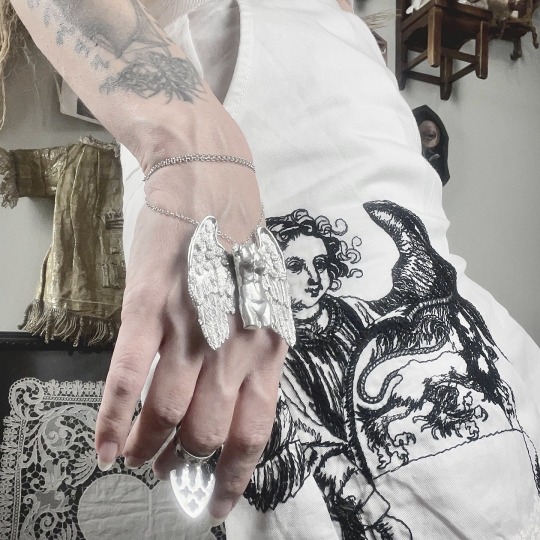
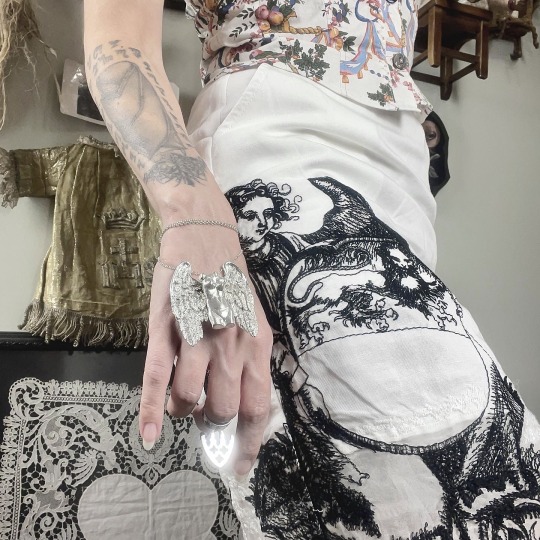
Jewelry by Moon and Serpent
#moon and serpent#handmade jewelry#artists on tumblr#angels#cherub#seraphim#wearable art#cupidcore#angelcore#gothic aesthetic#gothic jewelry#jewellery#greek goddess#roman statue#winged victory#angel wings#ancient roman#ancient greece
454 notes
·
View notes
Text

Romano-Caledonian Glass Bracelet Fragments, Perth Museum, Scotland
Fragments of five glass bangles, using coloured glass from Roman sources; locally fashioned and popular with Romans and Caledonians.
#romans#roman#roman jewellery#archaeology#glass#bracelet#ancient crafts#ancient cultures#ancient living#Scotland#relic#fragments#glasswork#jewellery#perth museum
38 notes
·
View notes
Text

emmaeboddy on depop & tiktok
#kieran culkin#succession#succession hbo#a real pain#scott pilgrim vs the world#handmade jewelry#jewelry#jewellery#jewellery making#depop jewelry#y2k jewelry#scott pilgrim#wallace wells#roman roy
32 notes
·
View notes
Text

A Roman cameo depicting a medusa mask in front view. Winged, surrounded by tangled hair, a snake knot under the chin. 1st - 2nd century CE, made of glass, turquoise, frame made of gold, enamelled.
Now housed at the Kunsthistorisches Museum in Vienna.
#reddit#artefactporn#fuckoff555#roman#cameo#medusa#mask#medusa mask#head#winged#snake#tangled#hair#1st - 2nd century century#glaas#turquoise#gold#enamel#enamelled#kunsthistorisches museum#vienna#austria#jewelry#antique#unknown jeweler#unknown maker#gorgon#jewellery#1st - 2nd century ce
36 notes
·
View notes
Text





Six Fanarts challenge part 1 - character 6
Daenys the Dreamer
requested by @holi.cos on insta
Daenys Targaryen, called Daenys the Dreamer, was a noblewoman of House Targaryen and the daughter of Aenar Targaryen, a nobleman from the Valyrian Freehold and the Lord of Dragonstone.
#illustration#artists on tumblr#chiara cognigni's art#chiara's art#digital illustration#digital art#fanart#art#pre asoiaf#a song of ice and fire#asoiaf art#asoiaf fanart#valyrianscrolls#old valyria#daenys the dreamer#daenys targaryen#ancient rome#roman empire#ancient history#jewellery#byzantine#lea seydoux#house targaryen#six fanarts#six characters#art challenge
66 notes
·
View notes
Text

Carnelian intaglio of Mars, Roman, 1st century AD
from The Art Institute of Chicago
#history#antiquities#art#jewelry#jewellery#ancient history#ancient rome#roman history#ancient jewelry#historical jewelry
386 notes
·
View notes
Text
SALVETE!

Hi everyone!!!!! mihi nomen est Arti - as I go by for my art - {arti.fexi on insta} (i drew my lil self portrait) - I'm just a simple puella, my Roman Empire is the Roman Empire, and that's basically what this blog is for
Classics, Latin, Mythology, Archaeology - my degree!!!! I'm having a whale of a time studying this so come say salve anytime if u like this sort of stuff - or any of the stuff tagged xxx I firmly believe in unaesthetic academia (or chaos so to speak but I like to think it has purpose) - I love my reading and my degree and my subject so let's just enjoy our work!!!! maybe sometimes i need reminding abt why I love my degree, because I'm sick of my work, but I don't think I could ever go into anything else...
Some summarised info abt me
~ I'm Arti, and I'm 20
~ I'm a Christian
~ I study Classics at Cambridge (in the UK :D) - which is predominantly what I talk abt
~ I v much love classics and always enjoy my classics and talking abt classics <3
#classics#ancient greece#ancient rome#greek mythology#latin#latin student#latinist#latinblr#classicsblr#archaeology#roman mythology#roman empire#ancient jewellery#writing#literature#artwork#drawing#writingblr#writers on tumblr#ancient literature#ancient languages#ancient greek#dark academia#light academia#chaotic academia#academia aesthetic
13 notes
·
View notes
Text
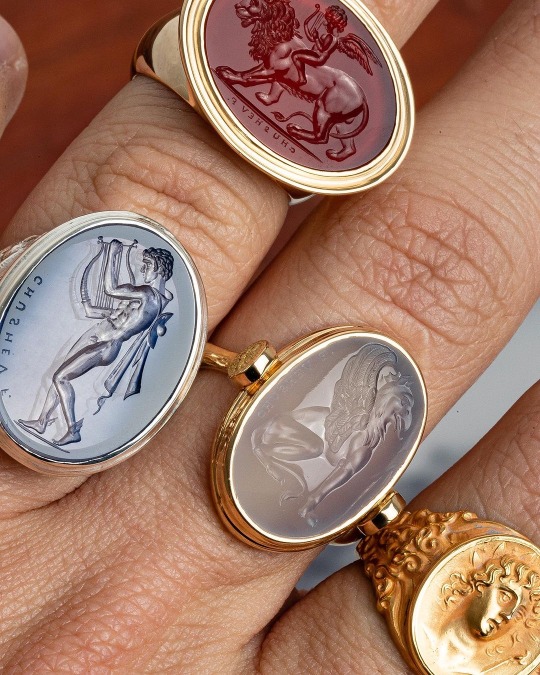
#men’s jewelry#jewelry#vintage jewelry#Roman#vintagestyle#style#intaglio#signet ring#gold jewellery#gemstone
58 notes
·
View notes